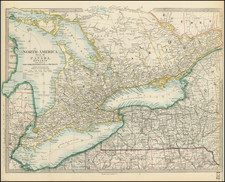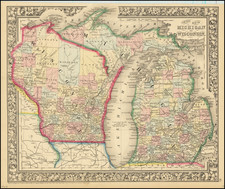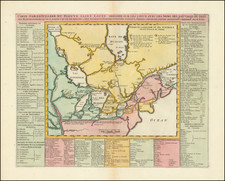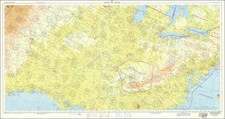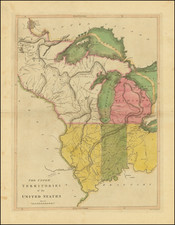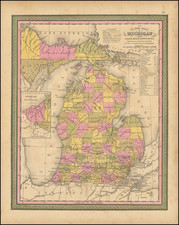One of Two Examples of the Earliest-Obtainable Plan to Show Woodward's Plan For Downtown Detroit
Incredibly rare map of Detroit, depicting a reconstruction plan for the city following the 1805 fire which destroyed the town. This map was produced to replace Augustus Woodward's original plan (which no longer survives) for the city after developers strayed from his vision. Several competing visions of the city were drawn up which attempted to balance the interests of various groups in the city, but Mullett's map (presented) would be the to define the layout of downtown Detroit.
The map shows Detroit from Grand Circus to the Detroit River waterfront. Streets, plot numbers, sewer lines, curches, and the facades of public buildings are shown. The plan follows the Woodward plan north of Campus Martius, but south of the square the layout switches to a grid-based structure (discussed below). Outside of the central area, farm plots can be seen, including the farm belonging to then-governor Lewis Cass, who was nearing the end of his eighteen-year term.
This map was engraved by James Otto Lewis, an early Detroit engraver who moved to the city to pursue an acting career. He supplemented his income with engraving work, becoming the first map engraver to work in Detroit, and was also present in several important expeditions around the Great Lakes to pursue treaties with the Indian inhabitants. He is best remembered for his Aboriginal Port Folio, a series of engravings of portraits of Native Americans from the Michigan region.
Two Competing Maps of Modern Detroit
Following the 1805 Great Detroit Fire, Augustus Woodward was charged with redesigning and expanding the city, with an additional 10,000 acres added to the city limits as a recompense for those who lost houses in the fire. Woodward based his plan on the recently built layout of Washington D.C., with large circuses and numerous radial boulevards. Sadly, no surviving examples of the original Woodward plan can be traced. The last mention of this map is by Aaron Greenly, a contemporary surveyor to Woodward, who used the map to patch a broken window.
While the Woodward design was accepted by the federal legislature (helped, no doubt, by Woodward's close friendship with Thomas Jefferson), later surveyors strayed from the original design. Further developments, such as the abandonment of Fort Shelby (formerly located near the present-day District Court) required redesigning of certain areas. Stakeholders disagreed vehemently regarding how these changes should be made. Plot holders disliked the original Woodward layout of the city because the angled streets led to less efficient use of their plots. Owners of riverfront property were opposed to any waterfront extension, as this was believed to devalue their property.
This presented example is the first of two maps of modern Detroit. The slightly earlier 1825 Philu E. Judd map, published posthumously, predates the abandonment of Fort Shelby. Thus, Mullett was employed to produce a new survey, having been appointed Surveyor of Michigan in 1825. Mullett's map, submitted to congress by the first Mayor of Detroit, John R. Williams, is described as by this latter individual in 1831 as follows in the Reports of Committees of the House of Representatives at the Second Session of the Twenty-First Congress:
“The corporation, for several years past, have employed Mr. John Mullett, a gentleman both intelligent and well qualified, as the city surveyor. After the new grounds had been laid out, and a considerable proportion thereof purchased by individuals, the public became anxious and desirous to have another plat of the city, with the improvements and alterations made since that published by Mr. Judd. Mr. Mullett was therefore employed, by the unanimous consent of all parties, to prepare and execute that work, The result is the map published in 1830, engraved by J. O. Lewis; five hundred copies were subscribed by the citizens of Detroit, at one dollar each. As far as my own observation and the information and remarks of others have enabled me to judge, I believe that map of the city to be as authentic and correct as any work of the kind can ordinarily be.”
On the presented map, Mullett reimagined Detroit south of Campus Mauritius, replacing Judd's radial streets (an extension of Woodward's original radial design) with a block and grid approach. This is the layout which survives in the city today.
Rarity
The Detroit Historical Society has the only other known example of this map, which is badly tattered and suffering significant image loss. No other example has been traced or been referred to.
Copies of this map were produced throughout the mid-to-late-1830s as part of the American State Papers, when the issue of the redesigning of Detroit reached the federal legislature. The map was again reprinted in 1860.









